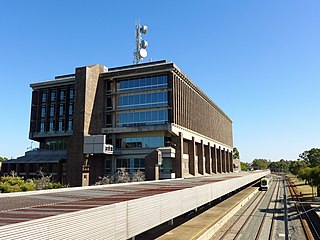
The Eastern Railway is the main railway route between Fremantle and Northam in Western Australia. It opened in stages between 1881 and 1893. The line continues east to Kalgoorlie as the Eastern Goldfields Railway.

The Prospector is a rural passenger train service in Western Australia operated by Transwa between East Perth and Kalgoorlie. On this service, two trains depart almost at the same time in opposite directions, one travelling between East Perth and Kalgoorlie, and the other between Kalgoorlie and East Perth. The original vehicles ordered in 1968 for trains providing this service were replaced in 2004 with vehicles capable of reducing journey times to 6 hours 45 minutes.

The Australind is a rural passenger train service in Western Australia operated by Transwa on the South Western Railway between Perth and Bunbury.

Australian Railroad Group (ARG) was an Australian rail freight operator. It began operations in Western Australia on 17 December 2000 following its purchase of the Westrail freight business. It was purchased by QR National in June 2006. The main commodities hauled by ARG included grain, mineral sands, alumina, bauxite, coal, woodchips, quartz, nickel and iron ore around Western Australia. In June 2011, it ceased trading as a separate brand, and became part of QR National.
Western Australian Government Railways (WAGR) was the operator of railway services in the state of Western Australia between October 1890 and June 2003. Owned by the state government, it was renamed a number of times to reflect extra responsibility for tram and ferry operations that it assumed and later relinquished. Its freight operations were privatised in December 2000 with the remaining passenger operations transferred to the Public Transport Authority in July 2003.

Railways in Western Australia were developed in the 19th century both by the Government of Western Australia and a number of private companies. Today passenger rail services are controlled by the Public Transport Authority through Transperth, which operates public transport in Perth, and Transwa, which operates country passenger services. Great Southern Rail operates the Indian Pacific.
The Western Australian Government Railways Commission was formed on 18 December 2000 to take over the non-freight operations of Westrail, following the freight operations being sold to Australian Western Railroad. It was the owner of the non-metropolitan rail network, that was leased to Australian Western Railroad, and responsible for regional passenger services, The Australind, AvonLink and The Prospector as well as regional coach services.

The Port Hedland–Marble Bar railway was a railway in the Pilbara region of Western Australia, running into the hinterland from the north-west coast.
The Northern Railway has had a number of meanings in Western Australian railway history.

The South Western Railway, also known as the South West Main Line, is the main railway route between Perth and Bunbury in Western Australia.

The Old Bunbury railway station was the main railway station for Bunbury from 1894 until 1996. It was the terminus for the Australind passenger railway service from Perth. It was replaced in May 1985 by the current Bunbury Terminal in East Bunbury.

The Railway Museum, also known as the Rail Transport Museum, is situated in Bassendean, Western Australia. It is run by the Western Australian division of the Australian Railway Historical Society (ARHS), which is called Rail Heritage WA.

The GT46C is a model of diesel electric locomotive designed and built by Clyde Engineering using Electro-Motive Diesel components. Entering service from 1997 for a number of Australian rail freight operators, those built for Westrail are known as the Q class, those for FreightLink are the FQ class and a single unit for Freight Australia is the V class. All 24 locomotives are currently owned by Aurizon since its purchase of One Rail Australia in October 2021.

Transperth Train Operations is a division of the Public Transport Authority of Western Australia. It is responsible for operating Perth’s urban passenger rail system, as part of the Transperth network.
Transperth is the brand name of the public transport system serving the city and suburban areas of Perth, the state capital of Western Australia. It is managed by the Public Transport Authority (PTA), a state government organisation. Train operations are done by Transperth Train Operations, a division of the PTA. Bus operations are contracted out to Swan Transit, Path Transit and Transdev. Ferry operations are contracted out to Captain Cook Cruises.

The WAGR S class was a class of 4-8-2 steam locomotives built by the Midland Railway Workshops between 1943 and 1947 and operated by the Western Australian Government Railways (WAGR).
The Esperance Branch Railway is a railway from Kalgoorlie to the port of Esperance in Western Australia.

The wheatbelt railway lines of Western Australia were, in most cases, a network of railway lines in Western Australia that primarily served the Wheatbelt region.

The Public Transport Centre is a terminal and administration building for public transport in Perth Western Australia. It is the centerpiece of East Perth Terminal, a standard gauge railway station and coach terminal adjacent to East Perth station on the Transperth narrow gauge suburban rail network.
Reece Waldock is a retired senior Australian public servant. Most recently he served concurrently as Director-General of the WA Department of Transport, Commissioner of Main Roads Western Australia and CEO of the WA Public Transport Authority, between May 2010 and July 2016.


















